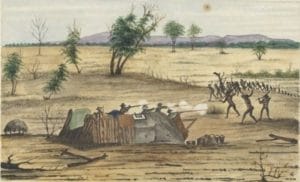During the last ice age Queensland’s landscape became more arid and largely desolate, making food and other supplies scarce. This led to the world’s first seed-grinding technology. Warming again made the land hospitable, which brought high rainfall along the eastern coast, stimulating the growth of the state’s tropical rain-forests.

European Arrival:
In February 1606, Dutch navigator Willem Janszoon landed near the site of what is now Weipa, on the western shore of Cape York. This was the first recorded landing of a European in Australia, and it also marked the first reported contact between European and Aboriginal Australian people. The region was also explored by French and Spanish explorers (commanded by Louis Antoine de Bougainville and Luís Vaez de Torres, respectively) prior to the arrival of Lieutenant James Cook in 1770. Cook claimed the east coast under instruction from King George III of the United Kingdom on 22 August 1770 at Possession Island, naming Eastern Australia, including Queensland, ‘New South Wales’.
The Aboriginal population declined significantly after a smallpox epidemic during the late 18th century. There has been controversy regarding the origins of smallpox in Australia; while many sources have claimed that it originated with British settlers, this theory has been contradicted by scientific evidence. There is circumstantial evidence that Macassan mariners visiting Arnhem Land introduced smallpox to Australia.
In 1823, John Oxley, a British explorer, sailed north from what is now Sydney to scout possible penal colony sites in Gladstone (then Port Curtis) and Moreton Bay. At Moreton Bay, he found the Brisbane River. He returned in 1824 and established a settlement at what is now Redcliffe. The settlement, initially known as Edenglassie, was then transferred to the current location of the Brisbane city centre. Edmund Lockyer discovered outcrops of coal along the banks of the upper Brisbane River in 1825. In 1839 transportation of convicts was ceased, culminating in the closure of the Brisbane penal settlement. In 1842 free settlement was permitted. In 1847, the Port of Maryborough was opened as a wool port. The first free immigrant ship to arrive in Moreton Bay was the Artemisia, in 1848. In 1857, Queensland’s first lighthouse was built at Cape Moreton.
Frontier War:
A war, sometimes called a “war of extermination”, erupted between Aborigines and settlers in colonial Queensland. The Frontier War was notable for being the most bloody in Australia, perhaps due to Queensland’s larger pre-contact indigenous population when compared to the other Australian colonies. About 1,500 European settlers and their allies (consisting of Chinese, Aboriginal and Melanesian assistants), were killed in frontier skirmishes during the nineteenth century. Casualties among the Aboriginal people may have exceeded 30,000. The “Native Police Force”, employed by the Queensland government, was key in the oppression of the indigenous people.

On 27 October 1857, Aboriginals retaliating against being poisoned and raped by members of the Fraser family, attacked the Hornet Bank pastoral station on the Dawson River killing eleven people. This was one of the largest massacres of British colonists by Indigenous Australians. The largest reported massacre of colonists by Aboriginals was in 1861 on the Nogoa River where 19 people were killed. One author estimates 24,000 Aboriginal men, women and children died at the hands of the Native Police in colonial Queensland between 1859 and 1897 alone.
Colony of Queensland:
A public meeting was held in 1851 to consider the proposed separation of Queensland from New South Wales. On 6 June 1859, Queen Victoria signed Letters Patent to form the separate colony of what is now Queensland. Brisbane was appointed as the capital city. On 10 December 1859, a proclamation was read by British author George Bowen, whereby Queensland was formally separated from the state of New South Wales. As a result, Bowen became the first Governor of Queensland. On 22 May 1860 the first Queensland election was held and Robert Herbert, Bowen’s private secretary, was appointed as the first Premier of Queensland. Queensland also became the first Australian colony to establish its own parliament rather than spending time as a Crown Colony. In 1865, the first rail line in the state opened between Ipswich and Grandchester.
